
30 June 2008
Mana Hebat Orang Melayu?

29 June 2008
Traditionalist Vs Modernist: The End of a Paradox?
By Ustaz Saiful Muhammad Pertubuhan Seni Silat Telapak Nusantara Malaysia http://senisilat.net/
28 June 2008
Silat In Movies
Silat has long been considered an esoteric martial arts form by the few Westerners that have heard of it or seen it. Recently, on History channel, the series Human Weapon, gave silat an international boost by showing two Westerners, one a champion martial artist and the other a footballer turned wrestler, learning and taking on silat fighters in Malaysia.
Though some of the fights were definitely staged, the segment when the two kweilohs 'studied' silat harimau was quite fascinating.
I remember TV once screening a local production that traced the various silat forms in the country - if I'm not mistaken the series was called Mahaguru and was directed by a silat exponent named Jak Othman. Since then, we hardly see any dramas, TV series or documentaries that promotes or demonstrates true or pure silat.
Even the movies have not been forthcoming with silat. Wonder why? Are we too ashamed to show our deadly martial arts to the world? Don't we want to share our beautiful martial arts with the rest of the world?
We filmmakers seem to be too preoccupied with the muay thais (ong bak), the kungfu (any bloody Jet Lee movie), the karate and judo of Japan, the taekwondo of korea and the Jeet Kune Do of Bruce Lee.
There was a time when even silat dramas in the early 90s, produced by HVD, unabashedly promoted Hongkee style martial arts as that of silat.
I know a few film directors who strived to show silat in its original form and this include Uwei Shaari whose Keris Lok Tujuh was one of the best TV dramas that exhibited Silat Melayu exquisitely.
In the early days of Shaw Brothers, the silat shown was basically silat wayang and whilst many said the best silat on show was that in the movie Hang Jebat and/or Hang Tuah, I beg to differ. There have been many other Melayu movies that showed silat in better light than those two over-rated movies.
Many also think the late P. Ramlee was a true silat exponent. Hehehe..he wasn't. If you see one of his later movies like Enam Jahanam, his movements were rather comical and sad at the same time.
Then there was a time when we tried to outdo the Indonesians, whose silat in the movies were also laughable - with fighters flying like superheroes on steroids. Some of the more memorable so-called silat movies from across the straits include Si Gondrong and Si Buta.
I even remember a rumor about the famous silat-trained actor Dicky Zulkarnaen (who has a gorgeous daughter mind you) who was said to have had a secret duel with Bruce Lee. According to the myth, Dicky executed his famous death punch on Bruce Lee that would only have an effect on Bruce sometime later.
So it happens, the so-called secret duel was said to have been held a few weeks before Bruce Lee's death.
Of course this is nonsense, we know Bruce Lee died because of the infamous curse of the dragon and that angry kungfu masters poisoned him for revealing Chinese kungfu secrets to the West. Hehehe.
But to tell you the truth, I have seen Dicky and his silat boys perform and they were very deadly and scary. They can break metal bars in half with their fingers and heads!
Okay, okay, coming back to the topic at hand, we filmmakers should be taken to task for not promoting silat properly. I mean, do we want to show the world that Silat Melayu is the one you see in Saw Teong Hin's Puteri Gunung Ledang? Puhleezzz.
When I did Tuah with Jamal Abdillah (who wouldn't really know what silat is even if it slaps him in the face), I needed a good silat choreographer. Luckily, I found one - Pak Engku, who had also choreographed the silat scenes in Rahim Razali's Matinya Seorang Patriot.
Pak Engku was great. He knew what I wanted and he helped make Jamal look good on camera.
Nevertheless, I wished I had casted someone else (but I wasn't the producer) but I ended up with Jamal. So I really had to make do with him. Below is an excerpt of the fight scene in my movie version of Tuah.
I have also found various silat scenes from Melayu movies including the ridiculous silat scene from the movie Putri Gunung Ledang for you to watch and compare. Enjoy.
If an obese and untalented actor like Steven Seagal can popularise Aikido, I don't see why we cannot find someone to promote silat as the deadliest martial arts in the world. Unless of course you saw Ong Bak and feel Tomoi is deadlier.
This article was sourced from the Malaysian movie director, Anwardi Jamil's blog at http://sayaanakwayang.blogspot.com/2008/06/silat-in-movies.html
27 June 2008
Silat Melayu Wallpaper

The above wallpaper was designed by a regular reader of Silat Melayu: The Blog, Mohd Fairuzuddin Faizan b. Mohd Yusoff the President of the Universiti Malaysia Sarawak chapter of Pertubuhan Silat Seni Gayong Malaysia.
The wallpaper depicts a Silat Seni Gayong grappling technique and includes a pantun from Poknik, also a regular visitor here. His pantun has appeared in this blog here. We thank Fairuzuddin for sharing this cool piece of work with us and hope to hear more from him. Thanks!(click on the picture above to download the full-sized wallpaper).
26 June 2008
Tradition vs Change: The Paradox of Silat?
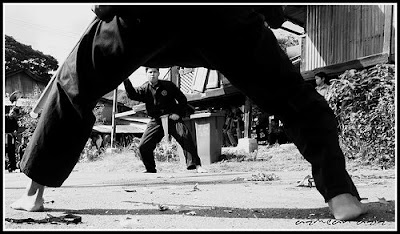 Malaysia is home to a multitude of Silat styles both traditional and modern. The scale on which these two broad categories sit is, of course relative and difficult to define.
Malaysia is home to a multitude of Silat styles both traditional and modern. The scale on which these two broad categories sit is, of course relative and difficult to define.
25 June 2008
Think & You Will Know
In a scene from the P. Ramlee movie, "Pendekar Bujang Lapok", Aziz Sattar chases away gangsters from his silat master's doorstep. As they leave, a gangster throws a rock at his head
Aziz: "Adoi! Pakcik! Dia orang lempar batu, pakcik!" (They threw a stone at me!)
Wak Mustar: "Kenapa kau tak elak?" (Why didn't you avoid it?)
Aziz: "Macam mana saya nak elak, silat elak batu pakcik belum ajar!” (How could I? You haven't taught us that yet!)
24 June 2008
Belajar Dari Ilmu
23 June 2008
Training children
 Teaching silat to children can be a chore, as many martial arts instructors already know. Their lack of acceptance of certain norms makes an adult instructor's life hell. One good thing though, is that children lack the mental barriers that adults have inadvertently placed on themselves.
Teaching silat to children can be a chore, as many martial arts instructors already know. Their lack of acceptance of certain norms makes an adult instructor's life hell. One good thing though, is that children lack the mental barriers that adults have inadvertently placed on themselves.
Silat is about freedom of action, and children are the freest souls on the planet. A mental barrier such as: "I'm not sure I can do this" or "This looks difficult" tends to cripple the zest and energy of adults, but strangely, kids have no such qualms, which can be dangerous in many respects.
But, if we can learn to harness this curousity, energy and flexibility very early on, they will grow into much better pesilat than their older counterparts. The only difference between them, is experience.
A child has absoulely no past experience to speak of, thus, they have very little opportunity to have a Eureka moment the way most adults do. A wise man's words are often understood by the wise, and this takes years to develop within a pesilat. So, how do we go about passing on this knowledge to kids if we have nothing to draw upon? Maybe all we have to do is look to ourselves.
I remember being that kid studying silat when I was in school, and I remember the kinds of problems I gave my instructor (he's a guru utama of his own style now). I also remember why it was so boring to learn and what about studying silat made me so interested. It was the discovery, or lack of it.
As a child, discovery is important. I read somewhere that the foundation of happiness is discovery, of learning something that puts you in awe. The thing I most remember about studying silat as a child was discovering that my instructor could walk on thorns on the field and do backflips with ease. THAT was silat for me, not the jurus which pained me to repeat.
Children sometimes like to spar as a way to test themselves, prove that they have what it takes. More often, it's to emulate the 'martial arts' they see on television. One way of getting them to focus is to turn their learning into a contest, to see who can perform the jurus better, cleaner, prettier and pay attention to those who lag behind.
Get one of them to lead the class and rotate, so they understand what it feels like when their fellow students don't follow their orders. Sooner or later, they will all understand your frustration and toe the line.
Kids today are thinkers. They want to know WHY. Prove to them that by doing it the correct way, they can gain more leverage, or more balance, or more... etc and they will be more motivated to practice. Training children is a balancing act, for sure, but it's better to allow a child to learn the way they're used to, by playing.

22 June 2008
Silat Melayu: The Tree of Discipline
Silat Melayu has been, for many hundreds of years, the traditional martial art practised by the Malays. Its uniqueness has been preserved by successive generations as sacred trust and a cultural burden. It integrates soft, aesthetic movements with self-defence techniques that are both hard and deadly.
It transcends the physical defence aspect to encompass the spiritual, medicinal and religious practises of the Malays. Without these three aspects, silat could be compared to a dish without the seasoning. A pesilat will never feel its pure essence if he familiarises himself only with the multitude of physical techniques.
Silat Melayu has been infused with the essences of the extraordinary, of mysticism and of godliness. In it one can rediscover the origins of man and the greatness of God. Silat Melayu has tread through a long and glorious history.
The annals of Malaysia have proven that before the advent of guns and cannons, the ancient Malay kingdoms of the Archipelago were well-defended against incursions from foreign empires, especially the Europeans and East Asians.
During that era, the Malays were known amongst the foreign traders not only from their appearance, but from their fighting prowess, customs and speech. Although techniques varied between one style and another, the cultural reality remained, that the applications of the body such as the fist, feet, knees, elbows and traditional weaponplay were similar if not identical.
A particular style could be identified from their salutations and wardances. Outside factors that influenced the growth of Silat Melayu in Malaysia includes those from the islands of Sumatera and Jawa.
Aspects of this can be seen in the clothing fashions, terminology of the movements, spiritual practises and the music that accompanies the wardances. In spite of this, the traditional concept of Silat Melayu remains unique and preserved. Every pesilat nurtures a similar ambition, to one day become a Pendekar.
A Pendekar is not simply an expert in the combat arts of silat, but is also able to master its spiritual and medicinal aspects. The mind of a Pendekar is like the wind. Its presence can be detected, but cannot be directly observed. His wisdom creates situations that makes his opponents lose their focus, thus incapable of anticipating his actions.
A pendekar is like a teacher. He is qualified to teach his students and may authorise any loyal disciples in the various branches of knowledge that he had acquired during his lifetime. However, to achieve the status of the Pendekar requires perseverance. Without years of immense courage and incalculable effort, all his works could be for naught.
Alternatively, this could also depend on their talents of mastery. Last to master means last to succeed. As with any other skill, silat requires disciples who would dedicate their lives to unearthing its secrets.
This is where silat is akin to a tree of discipline. The further we climb among its branches, the more we discover the meaning of brotherhood, patience and the revelations of its mystical secrets. Confidence is a pesilat's closest companion when faced with a multitude of physical and mental challenges that will surely block his climb to success.
Curiously, Silat Melayu was once regarded as giving undue emphasis to the softer movements of the human body. This could be the opinions of those who have yet to pluck the fruits at the highest branches of the tree.
It cannot be denied that such an opinion arose from the archaic tendency to close off silat from the outside world. Thus it has been lowly regarded as unable to adequately defend against hard, violent incursions.
However, the 1980s saw drastic reversal of this opinion, never to return. Due thanks are owed to those vanguard Nusantara masters who spread silat to the world, resulting in the continued acquaintance of the European and West Asian communities with the greatness of this art.
Now, the possibility of silat schools taking root overseas is increasing every day. Perhaps the attractiveness also comes from the fact that silat's physical training provides an alternative that is no less effective on the human body. The soft, undulating motions of the art invite the functions of the body towards the development of a more active mind and spirit. A sharp mind will flow only within an active body.
In silat exist storehouses of knowledge that can never be recorded nor revised on paper. The meaning of silat is found between its branches, its leaves, its flowers and its fruits. Only someone who can master that meaning can realise just how valuable a life of silat, within silat really is.
In closing, let us ponder upon the theme of the 1987 Kuala Lumpur International Silat Championship, "SILAT FOR ALL", a truly apt acknowledgement of silat's seeds being sown across the continents.
By Basir Haji Ghani Sourced and translated from PENDEKAR vol.7
21 June 2008
Five do Malaysia proud at symposium
A total of five members of the Pertubuhan Seni Silat Ikatan Kalam Utama Malaysia (PIKUM) had participated in the 16th Martial Arts Annual International Symposium at San Antonio, Texas, USA, recently.
The event was organised by the World head of Family Sokeship Council (WFHSC), an international body representing grand masters in all martial arts disciplines worldwide that is based in Florida, USA.
The symposium was an international event attended by martial arts practitioners in all disciplines such as San Jitsu, Ju Jitsu, Seicho Jutsu, Aiki Tora Ryu, Jeet Kume Do, Gati Chi, American Sambo and Seni Silat Kalam. More than 1,000 participants took part.
PIKUM delegates representing Malaysia received awards for their contributions in the martial arts world. They were Grandmaster Prof Dr Zahalan Man who was awarded Historical Member Award and Datuk Shahul Hamid M.A. Bakar (National Leadership Award).
The other three were Sheikh Shahawal 'Ali Sheikh Kamaruddin (National Convention Leadership Award), MR Mohan Ratha (International Convention Leadership Award) and Dr Farukh Abdullah (Peace Leadership Award).
The organiser also awarded Tourism Minister Datuk Seri Azalina Othman and Youth and Sports Minister Datuk Ismail Sabri Yaakob with the International Leadership Award as a tribute to their leadership.
The Malaysia delegation had participated in all main components mainly exhibition, workshop and seminar, competition and demonstrations, gala night dinner and handing over of the WFHSC highest award.
PIKUM is organising an exhibition to promote the 18th World Peace Congress event and 1st International Martial Arts Festival 2008 to be held at Sunway Resort Hotel and Sunway Pyramid Convention Centre from Oct 29 to 31. It is aimed at promoting Malaysia among martial arts practitioners.
Sourced from http://thestar.com.my/metro/story.asp?file=/2008/6/21/central/21546401&sec=central
20 June 2008
Silat routines rehearsal for Brunei Sultan's birthday celebration

Around 100 exponents showed their silat routines to the committee members of "His Majesty With the People" event last Wednesday night, one of many activities that will take place on July 20 when the ruler is expected to receive greetings from the population of Brunei Muara District at the Taman Hj Sir Muda Omar Ali Saifuddien in the capital.
Held at the multipurpose hall of Fire & Rescue Department headquarters in Berakas, the rehearsal was also witnessed by the Brunei Muara District Officer, Dato Paduka Awg Hj Md Yussop Bakar; his assistant, Hj Haris Othman; the event's Director of Field Performances, Awg Majid Alias; his deputy Awg Hanafiah Zaini; Head of Activity Coordination, Awg Hj Suhaili; and other committee members.
An integrated rehearsal will take place sometime in July at the event's venue, which will include other field performers.
By Rosli Abidin Yahya
Sourced from http://www.brunei-online.com/bb/fri/jun20h27.htm
19 June 2008
Silat In Malaysian Print
There is a definite dearth of Silat and Silat-related books on the market, be it locally or internationally. Many people are surprised to learn that Malaysia, the 'Mecca of Martial Arts' (quote from sifu Nigel Sutton in his SENI BELADIRI column 'Under The Palm Trees'), has less than ten books on Silat on the market, most of them either out of print or simply forgotten. Fortunately, silat has a media to call its own in SENI BELADIRI, Malaysia's premier martial arts magazine that began its run in August 1997 and has to this day more than 90 issues under its belt. Owned, operated and published by Azlan Ghanie, the magazine is bilingual in content with most of its articles in the Malay language. Azlan, who is also the founder and Primary Trustee of Silat Melayu Keris Lok 9 has interviewed several hundred masters in silat and non-silat styles, making him one of the most knowledgable martial artist in Malaysia when it comes to arts other than his own. In 2001, a radical effort saw fruition when SILAT WARRIOR was published. The only all-English martial arts magazine in Malaysia, it was exported to the West but didn't take off. It ran for three issues. In fact, this was not his first effort at publishing a martial arts magazine. In 1989, the first issue of PENDEKAR hit the stands with the final interview with the late, great Datuk Meor Rahman of Silat Seni Gayong fame to ever appear in the pages or any martial arts magazine. Azlan conceived and edited the magazine before being taken ill a few years later. PENDEKAR ran until 1995 without Azlan at the helm. During SENI BELADIRI's run, two other publishers tried to follow in its footsteps. Unfortunately, neither of them garnered the kind of popularity among the local martial arts com-munity the way SB did. The mystical martial art magazine TANGKAS saw print in 2002 but ran for a few issues before being put out of its misery. Meantime, SENI SILAT WARISAN BANGSA (no relation to my website SILAT SENI WARISAN BANGSA hosting at http://silat.8m.com) put up a valiant fight, eventually making it past the ten issue mark, even though it was forced to publish bi-monthly instead of monthly. There were also several attempts at one offs such as SILAT, MEGAT and TERAWIS, all by Megat Ainuddin Megat Mohd Nordin, the head of Silat Penjurit Kepetangan and GEMPITA, by Ustaz Azam Zulkifli of Silat Gayong Maarifat. Bear in mind however, that the print run and circulations hardly touch anything Western World magazines such as BLACK BELT and COMBAT have achieved. With a reported 3.5 million pesilat within Malaysia, it is unfortunate that the circulations skim only about 0.1% and below of this potential. Therefore, where magazines barely dare to tread, would books survive extinction easily in Malaysia? In my quest to build a library made up of silat-related books, it turns out that you just have to know where to look. My search took me to Dewan Bahasa Dan Pustaka, the national vanguard of language and literature. It seems that their main objective is to publish as many books in Bahasa Melayu as possible and leave them to rot with no marketing push behind them. Most silat books in Malaysia are published by this body. From them I managed to glean gems like TEKNIK DALAM SENI SILAT MELAYU (Techniques In Malay Silat) by Anuar Wahab, SENI SILAT MELAYU DENGAN TUMPUAN KEPADA SENI SILAT SEKEBUN (Malay Silat With Special Attention Given To Seni Silat Sekebun) by Tuan Ismail Tuan Soh and SILAT OLAHRAGA (in Malay and English versions) by Anuar Wahab. Out of print are SILAT TERLAK NATA by Hamzah Ahmad and KERIS DAN SENJATA-SENJATA PENDEK (The Keris and Other Short Bladed Weapons) by Shahrom Yub, the docu-novel PANGLIMA SALLEH SELEMPANG MERAH (Panglima Salleh Of The Red Sash) by Zaharah Nawawi and the period novelisation retelling of Hang Tuah's legendary childhood, SAKSILA LEKIR by Dr Mohd Nasir Zainal Abidin. Happily though, most of the books I mentioned above will soon be available in their English versions online. One of them, Silat Olahraga is already offered online at http://silat.tv. Check it out for yourself. Recently, Malaysians were blessed with the publication of the first real book on Silat exercises in SENAMAN SILAT JIWA SIHAT UNTUK SEMUA (Silat Exercises And Self Health For All) by Megat Ainuddin Megat Mohd Nordin and Assoc Prof Nor Anita Megat Mohd Nordin. It is an interesting addition to anyone's silat library. Other than these, there are several books self published by respective Silat perguruan for internal consumption. Most of them go out of print almost immediately due to the specific audience targeting. Although similar in that sense, many of them serve different purposes; com-memoration, official text book, promotion, etc. I have some of them, others, I have only had fleeting glimpses of. Silat Cekak Malaysia has two books, a commemorative coffee table book, SENI SILAT CEKAK MALAYSIA DALAM SUKU ABAD (Quarter Century) and BUDAYA CEKAK, a collection of 21 seminar papers on the art. Silat Cekak Hanafi has one self-titled official text book while Silat Kalam provided detailed explanation into its philosophy and thinking in WADAH KE ARAH WAJA DIRI SEJATI (The Means Towards True Self Empowerment). Kegayungan Acheh Helang Putih also self published two books on practical self-defence, one of them simply titled SILAT. I also know of one combat training manual published by Silat Seni Pusaka Gayong and a book by Silat Seni Gayong Malaysia but have yet to acquire either of them. The Malaysian Branch of the Royal Asiatic Society also collected 12 pieces on the Malay weapons and published it under the title THE KERIS AND OTHER MALAY WEAPONS (not to be confused with the Shahrom Yub publication). The last locally published book is a thin full coloured almost brochure-like SENI DALAM SENJATA MELAYU (The Aesthetics of Malay Weaponry) by Malaysian Handicrafts. From Malaysia, we step out slightly next door to Indonesia where all of the above books stand in awe of the masterpiece that left the keyboard of O'ong Maryono, which is PENCAK SILAT MERENTANG WAKTU (it has an English translation titled Pencak Silat In The Indonesian Archipelago), 414 pages of pure intimacy with Indonesian pencak silat. Finally, we have THE KRIS: MYSTIC WEAPON OF THE MALAY WORLD by Edward Frey. The book was published as part of an Images of Asia series by Oxford University Press in Singapore. These are the books I have come in contact with of which I have most.

17 June 2008
The Taming Sari

Standing in front of the legendary Taming Sari, one felt a sense of awe; all around, the air positively crackled with reverence. It was a rare chance to get a glimpse of this 500-year-old keris which was displayed at Galeri Sultan Azlan Shah in April in conjunction with the Sultan of Perak's 77th birthday.
Legend had it that the mystical Taming Sari could fly and seek out the enemy, just like modern missiles. Not only that but it would even rattle in its sheath to warn its owner of potential danger. In view of this, perhaps the glass showcase made good sense - for the protection of curious viewers, rather than the other way around!
Politics were pretty nasty even in 15th Century. When he wanted to ask for the hand in marriage of Majapahit princess Raden Galoh Chandra Kirana, Sultan Mansur Shah travelled to Java with his royal bodyguard Hang Tuah.
Unfortunately, Hang Tuah, instead of the Sultan, became the centre of attention there. This was the opportunity that Pateh Gajah Mada had been waiting for to oust Hang Tuah permanently from the Sultan's favourites list.
The envious palace official engaged a Javanese warrior, Taming Sari, to kill Hang Tuah but the tables turned and Hang Tuah won the fight as well as Taming Sari's keris (also named Taming Sari). Thus began the legendary saga of Malaysia's most celebrated dagger.
Taming Sari, classified as keris kuasa or bawar, is made of an alloy of 20 metal composites, some said to come from bolts holding Mecca's Holy Kaabah gates. A keris kuasa is said to possess supernatural powers and has to be "cleansed" in the melimau ceremony periodically to retain its potency.
When he could not persuade Puteri Gunung Ledang to marry Sultan Mahmud, Hang Tuah threw the Taming Sari into Sungai Duyong out of frustration. Tun Mamat did history a favour when he recovered it for the Sultan's safekeeping.
In 1511, the Portuguese conquered Malacca and Sultan Mahmud fled to ]ohor-Riau and later to Kampar in Sumatera. Taming Sari finally found a permanent home in Perak as part of its state regalia when Sultan Mahmud's son, Sultan Muzaffar Shah I, was installed as the first Sultan of Perak and the keris was passed on to his successors till present day.
The keris is a weapon peculiar to the Malay Archipelago which encompasses Thailand's Pattani region, Malaysia, Indonesia, The Philippines' Mindanao region and certain parts of Cambodia. Historians believe the first keris was developed in the 9th Century and perfected by the 14th Century. In Aceh, the keris is called rencong and Sulawesi, badik.
The keris is surrounded by mystery and there are tales of deaths being caused by simply thrusting the keris into a victim's footprints. Sculptures of keris, dating back more than 400 years have been found in Central Java's Chandi Borobudur where it is known as kujang.
Another keris frequently mentioned in Malay folklore is Keris Mahsuri though no one really knows where it is today. It was said to be the keris used to kill Mahsuri who was wrongly accused of adultery.
By Casey Ng
Sourced from New Straits Times (Travel Times) 24 May 2005
16 June 2008
Music for the fight, movements for the soul
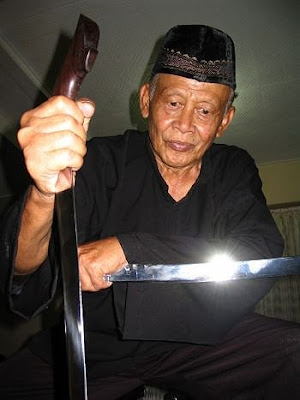 Pak Haji Uho performing
Pak Haji Uho performingWhile pencak silat is traditionally regarded as a sport for men, the artistic component of pencak silat seni offers women an attractive way to learn fighting skills. The beauty of the music and the choreographed movement allow practitioners to enjoy the art without the pain and struggle of combat practice.
In West Java, pencak silat seni is accompanied by a variety of local instruments. The most important of these instruments are the kendang (a double-sided barrel drum), the tarompet (a double-reed woodwind instrument) and the gong. The drums are used to accompany and illustrate the performers’ movements.
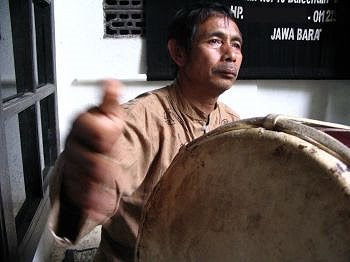 There are a variety of different rhythms which all have different origins, like the rhythm known as Paleredan, from the village of Palered, and Tepak Dua, from Cimande. The drummers follow the movements of the performer with their playing, and develop great sensitivity to the choreographed movements of the art form.
There are a variety of different rhythms which all have different origins, like the rhythm known as Paleredan, from the village of Palered, and Tepak Dua, from Cimande. The drummers follow the movements of the performer with their playing, and develop great sensitivity to the choreographed movements of the art form.Maenpo is a form of pencak silat from from Cikalong, Cianjur (West Java). It differs in two ways from contemporary pencak silat seni. Pencak silat seni is largely a choreographed art form in which the movements are illustrated by the music.
11 June 2008
Brunei Weaponry On Display
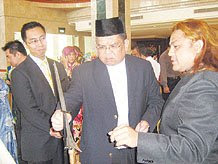
In a bid to showcase and reintroduce the culture and traditional items of the Brunei heritage, Orchid Garden Hotel (OGH) in cooperation with Kandarzari Krafts International yesterday launched the Brunei Traditional Weaponry exhibition at the OGH Lobby.
Deputy Permanent Secretary at the Ministry of Culture, Youth and Sports cum guest of honour Pg Hj Bahrom bin Pg Hj Bahar officially launched the opening of the exhibition.The day opened with a welcoming speech delivered by Shamsul Bahrin bin Pehin Dato Dr Hj Ahmad, who said, "Cultural tourism is fast gaining popularity in the Asian region. In Brunei, this is also evident in the government's efforts to enhance its products.
"Work on the Cultural Centre located in Kg Ayer has already commenced and we at Orchid Garden Hotel are also continuously working on finding ways to enhance and promote what Brunei has to offer.
"This exhibition is the second part of our Bruneian Exhibition for 2008 and is themed 'The Showcase of Weaponry.' There are a total of 20 historical items on display, related to past Brunei weaponry," he said.
"We are grateful for the support of the Brunei government, especially the Ministry of Culture, Youth and Sports, the Ministry of Industry and Primary Resources and Ministry of Home Affairs for supporting our effort in this exhibition.
"We will continue to bring two more exhibitions for the second half of 2008 with different themes. The purpose of these series of exhibitions throughout the year is not just to showcase Brunei's heritage to tourists, but also for locals and residents of Brunei to learn more about Brunei's legacy."
"We hope that our exhibitions will be a learning experience for everyone, especially the younger generation," he added.
Also speaking at the ceremony was Johan Suhaimi, owner of Kandarzari Krafts International, who encouraged the public and researchers to come and share the cultural information available at the exhibition.
Following the launching, the guest of honour was taken on a tour of the exhibition by the General Manager of OGH and owner of Kandarzari Krafts International, who enlightened him on the displayed items.
The exhibition is an effort by OGH to contribute to the community; diversify its standing in the community; present a platform to uphold culture, tradition, science and history; as well as support the KNK (Kenali Negara Kitani) movement.
The exhibition aims to expose and exhibit traditional items to the younger folks and the public, demonstrating the hotel's commitment in supporting the local cultures.
The guest exhibitor for the event, Kandarzari Krafts International, is presenting an exhibition of weaponry that dates back to 1700 AD and features various 'keris,' daggers, swords, vanity weaponry, shields, spears and a special item - the Impaling Iron or 'Kayu Sula,' which was used for execution purposes.
The exhibition is open to the public until August 10 and admission is free.
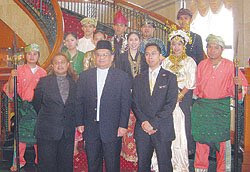
Sourced from http://www.brunei-online.com/bb/wed/jun11h28.htm
10 June 2008
Silat Cekak Hanafi Wajadiri Tournament 2008 Pictures & Results

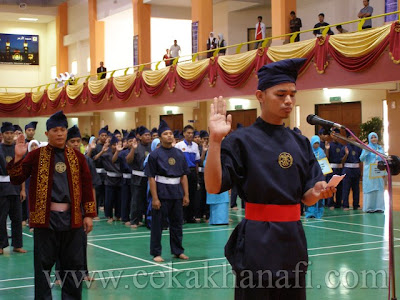
The Persatuan Seni Silat Cekak Ustaz Hanafi Malaysia National Wajadiri Tournament was held on 8th June 2008 at the Kolej Universiti Islam Selangor (KUIS), Bangi, Selangor. The event was officiated by The Honourable Datuk Ir. Hj Idris Bin Haron, Deputy Minister, Malaysian Ministry of Higher Learning.
Click below to view the album pictures.
09 June 2008
08 June 2008
Terengganu, Pahang Rule Silat
Siti Rahmah Mohd Nasir set the ball rolling by clinching the women's Class D 60kg-65kg gold after beating Pahang's Mazatul Haniza Zakaria while Mohd Hafiz Mahari added the second from the men's Class A 45kg-50kg category by beating Mohd Faizul Nasir from Selangor.
Salahuddin Shafie later gave the host their third gold medal of the day, edging Mat Nazri Mat Khalil from Perak in the men's Class H 80kg-85kg category before Mohd Ariff Sukir swept aside the challenges of Pahang's Samiruddin Shaari to bag the fourth gold in the men's Class I 85kg-90kg category.
Terengganu exponents who made it to five finals however failed to produce a 100 per cent record when Zul Effendi Yusoff lost to Mat Sabar Nordin of Penang in the men's Class E 65kg-70kg event.
With the four collected today, the host hauled in six gold medals from silat, the same number won by Pahang, considered a powerhouse in pencak silat competitions.Pahang who won two gold medals on June 3 and June 4, added four today with Mohd Hazwan Mahamad Hemdan leading the charge in the men's Class J 90kg-95kg gold after beating Selangor's Azrul Abdullah.
Muhamad Saiful Shafiq (men's Class G 75kg-80kg), Amir Ikram Abdul Rahim (men's Class D 60kg-65kg) and Amir Ikram Rahim (men's Class D 60kg-65kg) were the other contributors for Pahang.
Kedah were also big winners today with five gold medals, Penang picked up two while Sarawak, Perak, Kelantan and Negeri Sembilan won one each when the curtains came down on silat events today.
Sourced from http://www.bernama.com.my/bernama/state_news/news.php?id=338115&cat=et
04 June 2008
Fight Club

After several days of intense, sometimes hazardous instruction (“basically a five day torture session” according to Anderson), the two guys will then endeavour to take on a local expert.
As hosts of Fight Quest, Anderson and Smith are two tough but personable individuals with very different personalities but both are studious fighters with serious attitudes.
